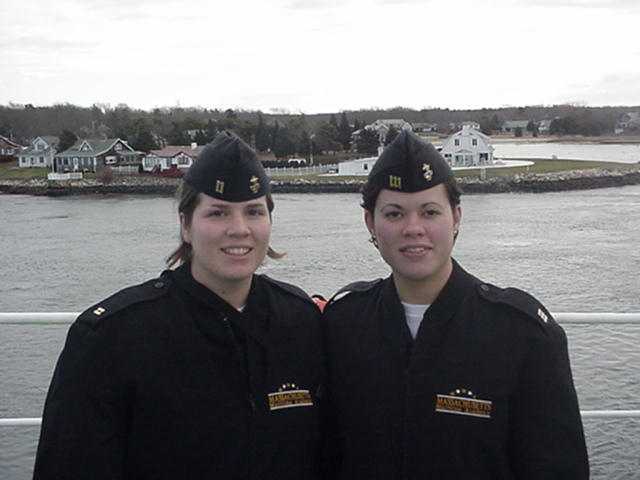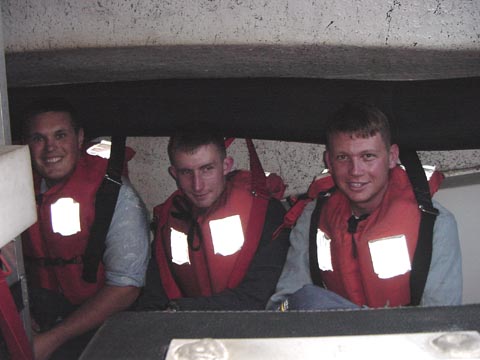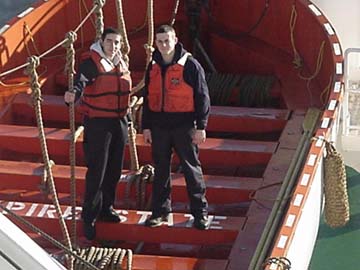
| January 2002 | ||||||
| Sun | Mon | Tue | Wed | Thu | Fri | Sat |
| 1 | 2 | 3 | 4 | 5 | ||
| 6 | 7 | 8 | 9 | 10 | 11 | 12 |
| 13 | 14 | 15 | 16 | 17 | 18 | 19 |
| 20 | 21 | 22 | 23 | 24 | 25 | 26 |
| 27 | 28 | 29 | 30 | 31 | ||
Thursday 17 January 2002
At 1200, EST the Training Ship Empire State was located at 34 degrees and 58 minutes North Latitude and 074 degrees 53 minutes West Longitude. Cape Hatteras, North Carolina was 33 nautical miles to the west. She was on a course of 206 degrees true traveling at a speed of 11.7 knots enroute to the Fort Lauderdale, Florida anchorage. Winds were from the southeast at 12 knots, air temperature was 66 degrees Fahrenheit barometric pressure was 1018 millibars, seas were from the north at 3 to 5 feet, sea injection temperature was 62 degrees Fahrenheit. Depth of water beneath the keel was 1500 fathoms.
CAPTAIN'S LOG
"Success, recognition, and conformity are the bywords of the modern world where everyone seems to crave the anesthetizing security of being identified with the majority." Martin Luther King, Jr., Strength to Love, 1963.
Our pre-underway checks went smoothly and we were ready when the Pilot embarked at 1900 last evening. We essentially reversed the arrival process and proceeded past the monocrome warships and out to sea. The Pilot left us at 2100. We took departure from Cape Henry Light at 2106, turned south and sailed quietly into the dark Atlantic night. This part of the world is renowned for the hundreds of maritime disasters that have occurred. We will sail near one of the most historic- the civil war ship USS Monitor. Parts of the first U.S. ironclad were recovered recently, but more still lie on the bottom just south of Cape Hatteras. It fell victim to a ferocious storm on New Year's, 1862. The many tragedies that have occurred in these waters can be traced to the convergence of warm tropical waters moving northward in the Gulf Stream and the cold waters of the Labrador current flowing south. The resultant zone of high differential temperatures is further excited by cold winter air moving eastward from the United States. Many of the terrible Nor'easters that strike New England are born where we sail today. Do you suppose the "bomb cyclone" that dealt us such a sound thrashing last Sunday may have started here? "Bomb cyclone" is the fancy name that meteorologist give to winter low pressure areas in which the barometric pressure falls at least 24 millibars in a 24 hour period. They are associated with cold fronts and they occur much farther north than tropical hurricanes. Regardless of the name that one gives them, they are frighteningly destructive storms packing hurricane force winds. The next time your local weatherman says, "...and the storm passed harmlessly out to sea..." remember, we'rrre heeeere.
I know that many are now wondering about the fact that we are enroute to anchorage in Fort Lauderdale. The answer to that is simple: the Play-offs. The Patriots are playing and to stave off mutiny I have decided to go in close, anchor, and broadcast the game over the ship's TV system. As an added safety precaution, pretzels will not be served. We have the extra time in the schedule and everyone will enjoy the evening just off shore. Those who do not like football can take an enthralling stroll about the main deck, watch the twinkling lights of Ft. Lauderdale, and fantasize about all that is so close, but yet so far away. Patience, we'll be back in a month.

While I have a moment, I want to introduce two very special cadets. These young women begin the Sea Term early in the fall semester and visit the middle schools and elementary schools that follow our voyage in the World Wide Classroom. This important work requires them to sacrifice a great deal of their meager spare time but they cheerfully complete these assignments in addition to the demands of varsity sports, regimental leadership duties, and significant academic responsibilities. They are also responsible for the photographs that embellish the daily Captain's Log. I must tell you, finding time to take excellent pictures is difficult when one considers the intensity of the daily schedule out here. However, they manage quite nicely and all would agree, the photos have been super. Both are frequent contributors to the Cadet's Comment section and are actively recruiting additional contributors to provide the readers with a diverse perspective on life at sea. They want to make this year's Captain's Log and the World Wide Classroom experience the very best yet. From this Captain's perspective, they are well along the road to success. Cadets 1/C Katlyn Ladden and Caryn Arnold are special people, among special people. I want you to know that. We are indeed proud to call them shipmates.

CADET'S COMMENT
A DAY AT SEA By 4/C Andrew Ferraioli
An awkward descent down three flights of stairs, quivering and shaking under of the awesome power of the treacherous sea, leads to a cold metal door. My pupils expand as I enter the consuming darkness that habitually engulfs the hold; home to 156 other cadets. I pass beneath red lights, their crimson glow fleetingly exorcise the blackness as I stumble to my rack. I struggle with flashlight and combination to open my adjacent locker. As the ship continues to roll, I hunt through six square feet of personal storage as I labor to find buried toiletries. I prepare for sleep, wash in a communal sink, and see a jaded young man looking back at me. Returning to the comfort of my blanket, I turn on my bunk light and open my journal. The quiet of night in the hold stands in stark contrast to the clamor of day. In the comforting silence, I reflect on the day and my present surroundings.
My rack is the bottom of three that hang suspended above a frigid metal deck. My neighboring shipmates sleep-except those who have taken my place on watch. Today was my first full day at sea and the first storm. 4/c Dirusso became confused from the storm's fury and I found him earlier today asleep in my rack instead of his own. The sea's nauseating anger caused many of my friends to become sick. The slight odor of sickness still hangs in the air. I try to ignore it as I write.
Today's bridge watch was amazing. Huge waves instigated by the storm's fury reached heights of more than twenty feet. The wind howled past me on the port bridge wing at more than 70 miles per hour. The ordinarily lumbering Empire State was tossed about like a toy boat in a child's bathtub. Not surprisingly, most of my day was spent trying to ignore the storm and escape the misery that claimed so many. At the end of the journal entry, I add a few sentences concerning she who is foremost in my thoughts. I write about Jen; I cannot wait to return to her arms.

QUESTIONS FRIDAY 18 JANUARY 2002
MATH: 7/8 of the Cadets aboard TSES live in New England. Express this fraction as a decimal. If the total number of cadets aboard is 495, how many are from New England?
SCIENCE: The atmospheric temperature that the Captain reports everyday is the result of the sun's energy. Name the ways that this energy is spread throughout the atmosphere
GEOGRAPHY: The TSES will pass close to the "Graveyard of the Atlantic"; More than 600 ships have been wrecked along this treacherous stretch of coast since the 16th century. Where is this area located?
HISTORY: It took many years for Congress to decide to celebrate the Dr. Martin Luther King's Holiday. When was the bill signed into law: What President signed it? When did the first national celebration of the Holiday occur?
ANSWERS FOR THURSDAY 17 JANUARY 2002
MATH: 495 x .20 = 99 were sick 495 x .65 = 321 took medication 65% + 20% = 85% were sick or took medication 100-85 = 15 percent not bothered. 495 x .15 = 75 cadets not bothered (Did not get sick or take meds)
SCIENCE: An estuary is a semi-enclosed basin with fresh water entering at one end and salt water flowing in at the other. Fresh water flows into the Chesapeake Bay from the James, Potomac, Susquehanna, and York, rivers, salt water flows in from the Atlantic Ocean. (50% of the fresh water comes from the Susquehanna)
GEOGRAPHY: The Susquehanna River does not flow through Pittsburgh.
HISTORY: Both events happened in 1861.